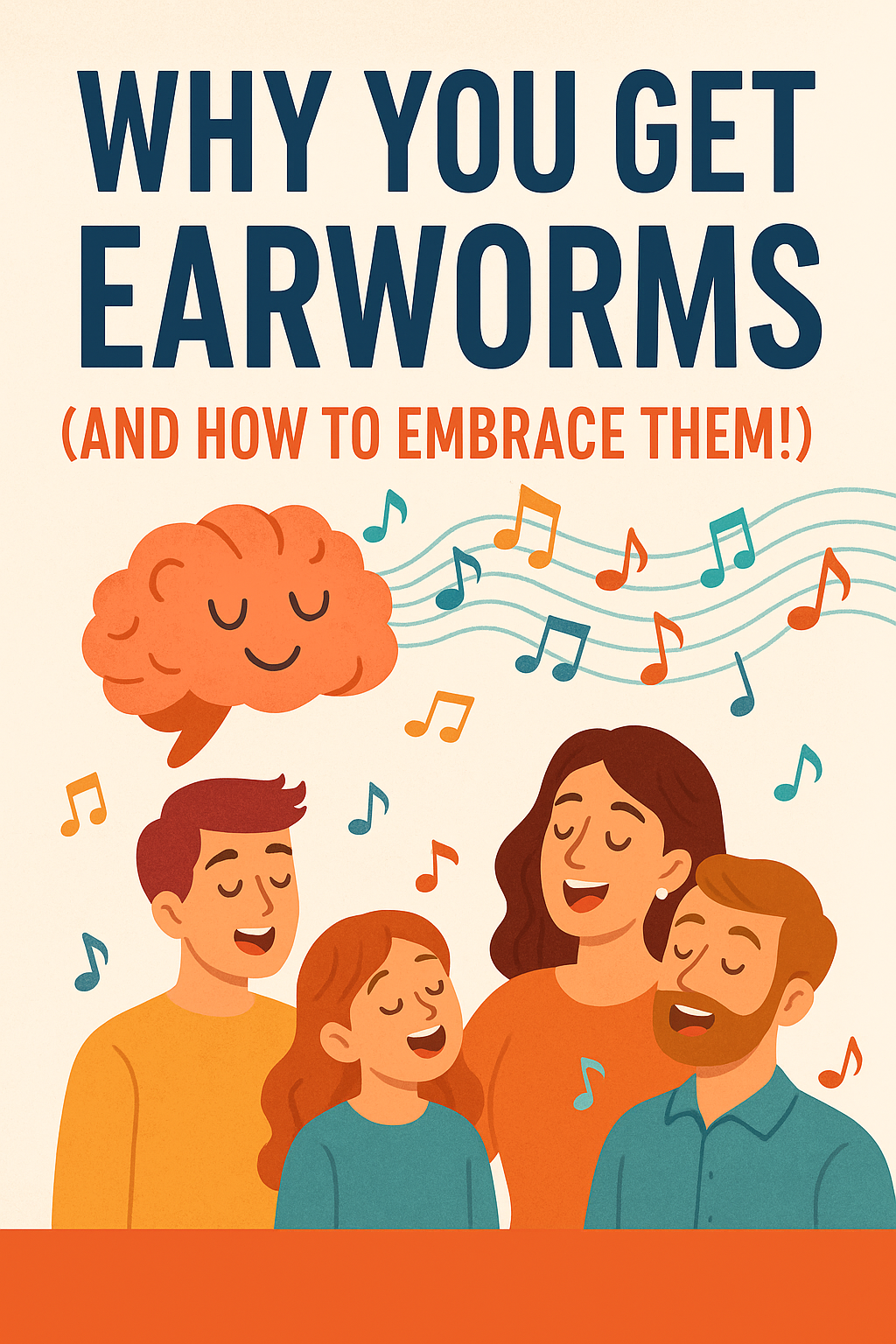Earworms: 7 Shocking Reasons They Control Your Brain

Ever catch yourself humming that annoyingly catchy tune from a commercial while you’re trying to focus on important tasks? Welcome to my world! As a dad of six kids ranging from 6 to 20, I’m constantly bombarded with everything from Disney soundtracks to whatever’s trending on TikTok. Trust me, when you’ve got five daughters, you’ll know every Taylor Swift song whether you want to or not! 😅
The phenomenon we’re dealing with has a name: earworms. These musical mind parasites are way more complex and fascinating than you might think. Let’s dive into the science, psychology, and sheer chaos of why certain songs hijack our brains and refuse to let go.
What Are Earworms and Why Do They Happen? 🧠
You know that moment when you wake up with a song already playing in your head, even though you haven’t heard it in weeks? That’s your brain’s musical filing system gone rogue! The German word ‘Ohrwurm’ literally translates to “earworm,” coined by psychiatrist Cornelius Eckert in 1979. But here’s what’s really wild – these aren’t just random musical hiccups in our brains.
Earworms are involuntary musical imagery that can repeat for hours, days, or even weeks. They’re essentially your brain’s way of processing and storing musical information, but sometimes the system gets stuck on repeat like an old CD player. Scientists have discovered that earworms trigger dopamine release in our brains – the same pleasure chemical we get from eating chocolate or achieving goals.
When my 15-year-old Melody plays the same song on repeat (and I mean literally 47 times), my brain starts craving that dopamine hit whether I like the song or not! It’s like my neural pathways develop their own musical addiction, independent of my conscious preferences. Research from the University of London shows that up to 98% of people experience earworms regularly. So if you thought you were alone in this musical madness, think again.
What makes this phenomenon even more fascinating is how democratic it is. Your brain doesn’t distinguish between songs you love and songs you hate when creating these musical loops. I’ve had songs stuck in my head that I genuinely cannot stand, yet there I am, mentally singing every word while trying to help with homework. According to research published in Psychology of Music, the average earworm episode lasts about 27 seconds and occurs most frequently during periods of low cognitive demand.
The Science Behind Musical Mind Control 🔬
The neurological mechanics of earworms are absolutely mind-blowing when you dig into the research. Your brain essentially becomes a biological jukebox, playing the same track on repeat without any external input. Here’s where things get really interesting: earworms activate the same brain regions involved in music perception, memory, and emotion. When a song gets stuck, your auditory cortex essentially plays the tune on repeat, even without external stimulation.
Dr. James Kellaris from the University of Cincinnati has spent years studying what he calls “cognitive itch” – that mental irritation that makes you want to scratch by hearing the song again. His research, published in the Journal of Consumer Psychology, reveals fascinating patterns about musical stickiness. Kellaris found that certain musical characteristics make songs more likely to become earworms, and understanding these patterns helps explain why some tunes are practically inescapable.

Repetitive melodies with simple, predictable patterns are earworm gold. Think about songs like “Happy Birthday” or “Twinkle, Twinkle, Little Star” – they stick because of their repetitive nature and simple chord progressions. Unexpected musical intervals also play a crucial role. When a melody has an unusual jump or twist, your brain wants to “complete” the pattern, creating that mental loop that drives you crazy.
The emotional connection factor is huge too, and this is where family life gets really interesting. Songs associated with strong memories or feelings are more likely to become sticky. Every time I hear certain songs, I’m transported back to specific moments with my family – good or bad! Temperature and stress levels can influence earworm frequency as well. When you’re anxious or tired, your brain is more susceptible to these musical intrusions.
7 Types of Songs That Become Instant Earworms 🎵
After years of research and lived experience in a household where musical tastes collide daily, I’ve identified the categories of songs that are basically earworm factories. These aren’t just random observations – they’re backed by scientific research and confirmed by millions of people who’ve fallen victim to these musical mind traps. Understanding these categories can help you identify potential earworms before they take up permanent residence in your brain.

The psychology behind musical stickiness involves several cognitive factors working together. Songs that combine repetitive elements, emotional resonance, and cultural familiarity create perfect storms for mental replay. Through years of experience (and scientific research from institutions like Goldsmiths University of London), certain categories of songs consistently dominate earworm territory:
1. Commercial Jingles and Theme Songs
These are specifically designed to stick! Companies spend millions creating memorable hooks. Think McDonald’s “I’m Lovin’ It” or that Kit-Kat jingle. My kids still sing commercials from shows that went off the air years ago.
2. Pop Anthems with Simple Choruses
Songs with easy-to-remember choruses dominate earworm territory. The simpler the lyrics and melody, the more likely they’ll camp out in your brain rent-free.
3. Childhood Songs and Lullabies

These have unfair advantages – they’re embedded during our most impressionable years. “Row, Row, Row Your Boat” probably lives somewhere in every adult’s brain, ready to surface at any moment.
4. Holiday and Seasonal Music
Christmas songs are earworm champions. Come December, “Jingle Bells” and “Silent Night” take up permanent residence in millions of minds worldwide. In our house, Christmas music starts in November (thanks to my wife’s influence), and by January, we’re all mentally exhausted from the seasonal soundtrack.
5. Current Chart-Toppers
Whatever’s dominating radio and streaming platforms has built-in earworm potential. The algorithms that determine hit songs actually factor in “stickiness” – how likely a song is to get stuck in listeners’ heads.
6. Nostalgic Throwbacks
Songs from your teenage years or early adulthood have special earworm powers. They’re tied to formative memories and identity development, making them incredibly sticky.
7. Movie and TV Soundtracks
Theme songs from beloved shows or memorable movie moments become earworms through association. The emotional connection amplifies their staying power.
The Positive Side: When Earworms Actually Help 🌟
Here’s something that might surprise you – not all earworms are musical torture devices sent to destroy your concentration! Before you start viewing earworms as purely annoying brain parasites, consider their genuinely beneficial aspects. The same neurological mechanisms that make songs sticky can actually work in your favor when harnessed properly.
Research from cognitive psychologists has revealed that musical earworms can actually improve cognitive function in several measurable ways. Dr. Lassi Liikkanen from Aalto University has published extensive research showing that earworms serve important psychological and cognitive functions. Understanding these benefits can help you reframe your relationship with these persistent musical visitors.
Memory enhancement happens when familiar songs help us remember information. I’ve used this technique with my kids for years – turning multiplication tables into songs or creating musical mnemonics for spelling words.
Mood regulation is another positive aspect. Sometimes a happy, upbeat earworm can lift your spirits during tough moments. When I’m dealing with deployment memories or family stress, certain positive songs can shift my mental state.
Creative inspiration often comes through musical loops. Many artists and writers report getting ideas while earworms play in their minds. The repetitive nature can free up other parts of your brain for creative thinking.
Social bonding happens when shared earworms create connections. When my family spontaneously breaks into the same song, it creates these beautiful moments of unity. Even my 6-year-old son Brayden joins in, usually with his own hilarious version of the lyrics.
The meditative quality of earworms can be surprisingly calming. Sometimes having a gentle, familiar tune playing in your mind provides comfort during stressful situations.
Why Some People Get More Earworms Than Others 🤔

The earworm experience isn’t universal – some people seem to have mental jukeboxes that never stop playing, while others rarely experience persistent musical loops. As someone who’s observed this phenomenon across multiple generations in my household, the individual differences are fascinating and significant. Scientific research has identified several key factors that influence your personal earworm susceptibility, and understanding these can help explain why your musical brain works the way it does.
Individual variation in earworm frequency ranges dramatically – some people report multiple earworms daily, while others might experience them only weekly or monthly. This isn’t just about musical exposure; it’s about fundamental differences in brain structure, personality, and cognitive processing. Studies from the University of Cincinnati and other research institutions have pinpointed specific factors that make some people more prone to these musical mind loops:
Musical training actually increases earworm frequency. People who play instruments or have formal music education tend to get more songs stuck in their heads. Makes sense – their brains are more attuned to musical patterns and structures.
Personality traits play a role too. Research shows that people who are more open to experiences and have active imaginations tend to experience more earworms. Creative individuals often report higher frequencies of musical intrusions.
Gender differences exist, with women reporting earworms slightly more often than men. However, the difference isn’t dramatic, and individual variation is significant.
Age factors are interesting – younger people tend to experience more earworms, possibly due to greater music exposure and brain plasticity. But honestly, as a dad surrounded by constantly changing musical tastes, I feel like my earworm frequency has actually increased over the years!
Mental health connections exist too. People experiencing anxiety or depression may notice changes in their earworm patterns. Sometimes music becomes more intrusive during difficult periods, while other times it provides necessary emotional regulation.
The Dark Side: When Musical Loops Become Problematic 😰

While most earworms are harmless quirks of human cognition, they can occasionally cross the line from amusing to genuinely disruptive. I’ve experienced this firsthand during particularly stressful periods – what starts as a simple song can transform into a mental prison that affects sleep, concentration, and overall well-being. Understanding when earworms become problematic is crucial for maintaining good mental health and knowing when to seek help.
The difference between normal earworms and problematic ones often comes down to intensity, duration, and impact on daily functioning. Research published in Psychomusicology indicates that while 99% of people experience earworms, only a small percentage find them genuinely distressing. However, when earworms do become problematic, they can significantly impact quality of life:
Sleep disruption happens when songs play on mental repeat during bedtime. I’ve experienced nights where a particularly catchy tune made it impossible to quiet my mind for sleep.
Concentration issues arise when earworms interfere with work or important tasks. Trying to balance military duties while “Baby Shark” played on infinite loop in my head was definitely challenging!
Anxiety amplification can occur when negative or stressful songs become stuck. Sometimes earworms reflect our emotional state, and disturbing or sad songs can worsen mental health symptoms.
Compulsive behaviors occasionally develop around earworms. Some people feel compelled to listen to the actual song to “complete” the mental loop, which can become disruptive.
For most people, these issues are temporary and manageable. But if earworms significantly impact your daily functioning or mental health, it’s worth discussing with a healthcare provider.
5 Proven Strategies to Stop Unwanted Earworms 🛑
When earworms transition from amusing background music to annoying mental interference, you need practical tools to regain control of your mental soundtrack. These aren’t just folk remedies or wishful thinking – they’re evidence-based strategies that have been tested and proven effective by cognitive researchers and music psychologists. I’ve personally tested all of these methods during my most challenging earworm episodes, and several have become go-to solutions in our household.
The key to successful earworm management is understanding that different strategies work for different people and different types of musical loops. What breaks a pop song earworm might not work for a commercial jingle, and what helps during stress-induced earworms might fail during happy musical loops. Research from Applied Psychology suggests that successful earworm intervention requires matching the strategy to both the individual and the specific situation:
1. The Completion Method
Listen to the actual song from beginning to end. This often satisfies your brain’s need to “complete” the pattern and can break the mental loop. I’ve used this countless times when one of my daughter’s songs gets stuck and drives me crazy.
2. Mental Distraction Techniques
Engage in activities that require focused attention – puzzles, reading, complex conversations, or mathematical problems. The key is finding something engaging enough to redirect your mental resources.
3. The Replacement Strategy
Deliberately think of a different song, preferably one that’s calming or less sticky. I keep a mental playlist of “safe” songs that don’t tend to become problematic earworms.
4. Physical Activity
Exercise, especially activities with rhythm like walking or dancing, can help reset your mental music player. When my family goes on hiking adventures, the physical activity and nature sounds usually clear any persistent earworms.
5. Mindfulness and Meditation

Practicing mindful awareness of your thoughts without judgment can help reduce the emotional frustration around earworms. Sometimes accepting the musical loop rather than fighting it makes it fade faster.
The Family Factor: How Earworms Spread Through Households 👨👩👧👦
Living with six kids has given me a PhD-level education in earworm transmission patterns that most parents never get to experience. Musical contagion is absolutely real in family settings, and it operates through mechanisms that are both fascinating and occasionally maddening. What starts as one child’s favorite song can become the entire household’s involuntary mental soundtrack within hours.
The science behind familial earworm transmission involves several psychological and social factors. Repeated exposure increases the likelihood of musical stickiness, but emotional context amplifies the effect even more. When songs are associated with family activities, shared experiences, or emotional moments, they become exponentially more likely to lodge in everyone’s brains. Research on social contagion shows that earworms spread through families via both conscious sharing and unconscious exposure.
When one child discovers a new song, it spreads through our household like wildfire. Currently, my 13-year-old Gabrielle is obsessed with a particular artist, and now I catch myself humming songs I’ve never intentionally listened to.
Age-related preferences create interesting dynamics. My older daughters (Natalie and Allyson) introduce more mature musical tastes, while Brayden brings home whatever’s popular in elementary school. The collision of these different musical worlds creates a fascinating (and sometimes chaotic) household soundtrack.
Shared earworm experiences actually strengthen family bonds. When we’re all stuck with the same song, it becomes a shared joke or reference point. These musical moments create memories that last long after the earworm fades.
The challenge comes when family members have conflicting musical tastes. What’s a pleasant earworm for one person might be torture for another. We’ve learned to be mindful about creating family harmony even in our musical choices.
Technology’s Role in Modern Earworm Culture 📱
Today’s technology has dramatically changed how we experience earworms:
Streaming algorithms are designed to create addictive listening patterns. The songs suggested by Spotify or Apple Music often have high earworm potential because the algorithms prioritize “engagement” – which includes how likely a song is to stick in your head.
Social media integration spreads earworms faster than ever. TikTok, in particular, has become an earworm factory, with short, catchy clips designed to loop endlessly. My teenagers can identify songs from 15-second clips that I’ve never heard in full.
Accessibility means we’re exposed to more music than any generation in history. This increased exposure naturally leads to more frequent earworms.
Background music in stores, restaurants, and online content constantly seeds new potential earworms. We’re rarely in truly quiet environments anymore.
The positive side is that technology also gives us tools to manage earworms – we can quickly access songs to “complete” mental loops or find alternative music to break unwanted patterns.
Cultural and Generational Differences in Musical Stickiness 🌍
Different cultures and generations experience earworms differently:
Cultural musical patterns influence which songs become sticky. Traditional folk melodies, religious music, and culturally significant songs often have enhanced earworm potential within specific communities.
Generational markers create shared earworm experiences. People who grew up in the same era often have similar “default” earworms – songs that were omnipresent during their formative years.
Language factors play interesting roles. Songs in your native language tend to create stronger earworms because your brain can process both melody and lyrics simultaneously.
Exposure timing matters too. Songs you hear during adolescence and early adulthood often become lifelong earworm candidates due to their connection with identity formation and peak neuroplasticity.
In our military family, we’ve lived in different regions and been exposed to various musical cultures. This diversity has actually enriched our musical experiences while creating more varied earworm patterns.
The Psychology of Musical Memory 🧠
Understanding why earworms work reveals fascinating insights about human psychology:
Pattern recognition is fundamental to how our brains process music. We’re naturally wired to identify and complete patterns, which makes repetitive musical structures irresistible.
Emotional tagging means songs connected to strong feelings become more memorable and sticky. This is why music often connects to family memories in such powerful ways.
Incomplete tasks (the Zeigarnik effect) create mental tension that keeps earworms active. When a song starts playing in your head but doesn’t reach a natural conclusion, your brain keeps trying to “finish” it.
Cognitive load influences earworm frequency. When you’re mentally tired or stressed, your brain has fewer resources to resist repetitive musical patterns.
Identity connection makes certain songs part of your psychological landscape. Music becomes intertwined with self-concept, making related earworms feel more personally significant.
When Earworms Become Creative Fuel 🎨
Some of the most interesting earworm experiences happen when these musical loops inspire creativity:
Songwriting inspiration often comes from earworm patterns. Many musicians report that their biggest hits started as persistent musical ideas that wouldn’t leave their heads.
Problem-solving enhancement can happen when earworms free up other cognitive resources. Sometimes having a gentle musical background allows your mind to work on challenges more creatively.
Memory techniques use earworm principles intentionally. Setting information to music makes it more memorable – a strategy I’ve used extensively in helping my kids with academic success.
Emotional processing often occurs through musical loops. Sometimes earworms help us work through feelings or experiences by providing a soundtrack for internal reflection.
The key is learning to distinguish between helpful and disruptive earworms, then developing strategies to encourage the positive ones while managing the problematic ones.
The Future of Earworm Research 🔬
Current scientific understanding of earworms continues evolving:
Neuroscience advances using brain imaging technology are revealing more about the specific neural pathways involved in involuntary musical imagery. This research may eventually lead to targeted interventions for problematic earworms.
Artificial intelligence is being used to study what makes songs sticky, potentially leading to better understanding of musical cognition and memory.
Therapeutic applications are being explored for conditions like depression, anxiety, and memory disorders. Understanding earworm mechanisms might help develop music-based treatments.
Educational implications could revolutionize how we teach and learn, using earworm principles to make information more memorable and engaging.
As a family constantly navigating the intersection of music, memory, and daily life, I’m fascinated by these developments and their potential impact on future generations.
Embracing the Musical Chaos 🎉

After years of living with earworms – both my own and those transmitted by six musically-diverse children – I’ve learned that fighting them is usually futile. Instead, I’ve found peace in accepting these musical mind visitors as part of the human experience.
Earworms connect us to memories, emotions, and each other in ways that pure silence never could. They’re evidence of our brain’s incredible ability to find patterns, create meaning, and hold onto beauty.
Musical diversity in our household has taught me that earworms aren’t good or bad – they’re just part of how our minds process the soundtrack of our lives. What matters is learning to work with them rather than against them.
Family dynamics around music have shown me that shared earworms can actually strengthen relationships. When my whole family spontaneously breaks into the same song, those moments become precious memories that outlast any temporary annoyance.
The next time you catch yourself humming an unwanted tune or find a song playing on repeat in your mind, remember: you’re experiencing one of the most uniquely human phenomena. Our ability to carry music in our heads, to replay melodies and lyrics without external sound, is actually pretty amazing when you think about it.
Whether your current earworm is a guilty pleasure pop song, a commercial jingle, or something one of your kids introduced you to, embrace it as evidence of your brain’s remarkable musical processing power. And if it gets too annoying, well, now you have some science-backed strategies to help you out!
What earworm is currently living rent-free in your head? Whatever it is, you’re definitely not alone in the experience. We’re all just trying to navigate this musical journey together – one sticky song at a time! 🎵
🌐 Explore More from My Family of Blogs
If you found this article helpful, you might also enjoy what I’m sharing across my other platforms. Each one is designed to uplift, equip, and inspire families in real, practical ways:
🏠 Mountains Will Move
Faith-based encouragement for everyday families. I dive into prayer, parenting, purpose, and pressing through life’s hardest seasons with Jesus at the center.
👉 Visit Mountains Will Move »
🔎 Everyday Exposed
My no-filter truth hub—where I tackle myths, challenge misleading narratives, and bring clarity to the conversations that matter most.
👉 Visit Everyday Exposed »
Whether you’re diving deeper into pet care, faith, or uncovering truth in today’s noisy world, I hope you’ll journey with me.
Thank you for being part of the journey. God Bless you and your family. 🙏
